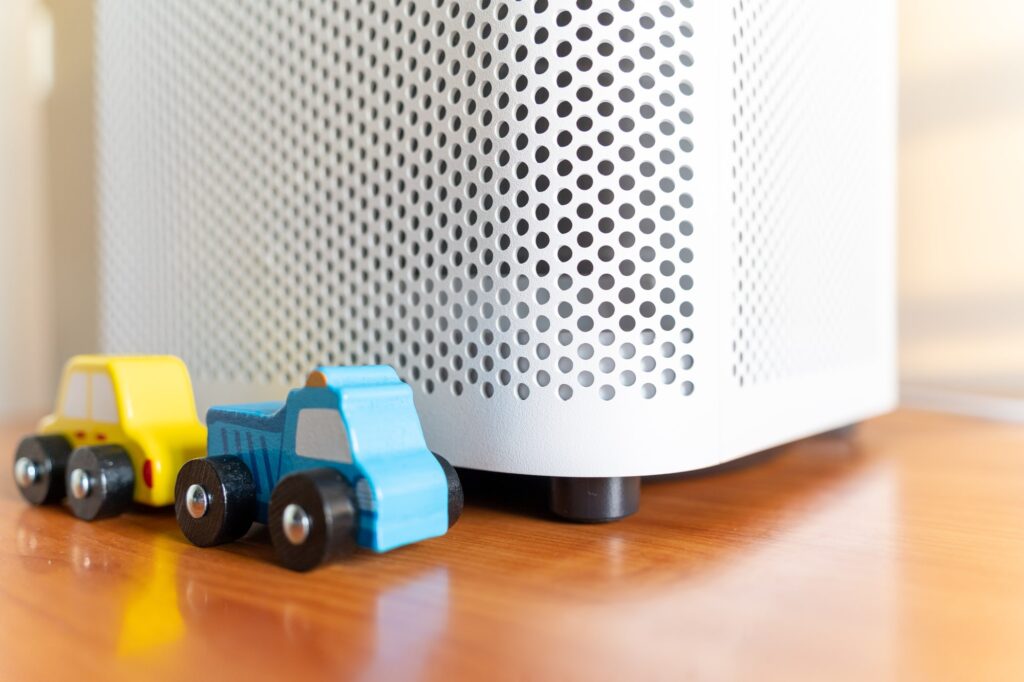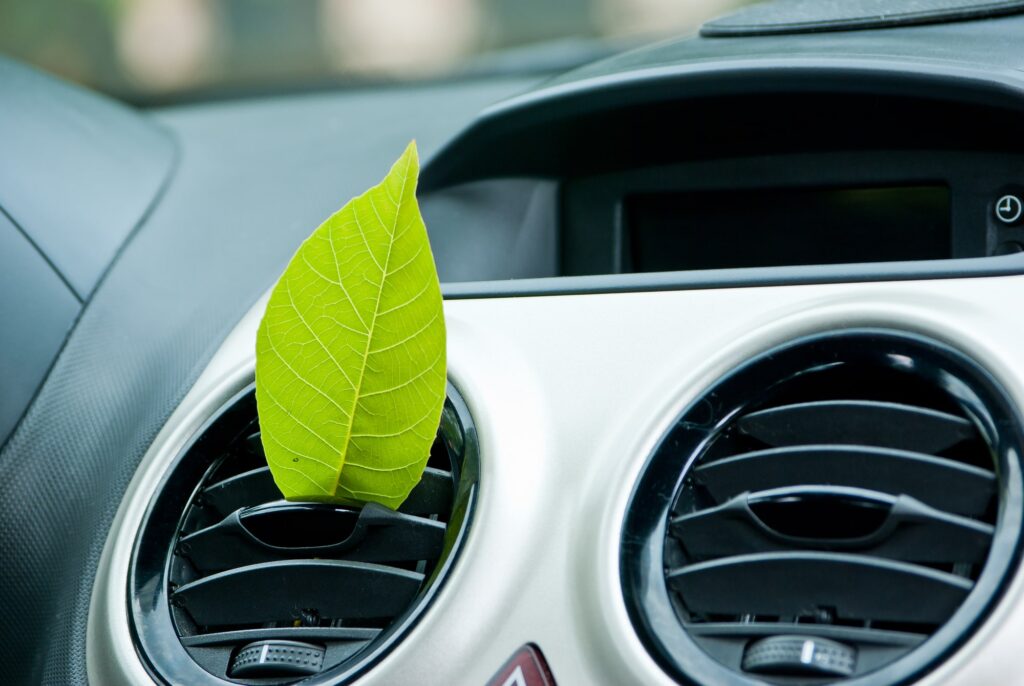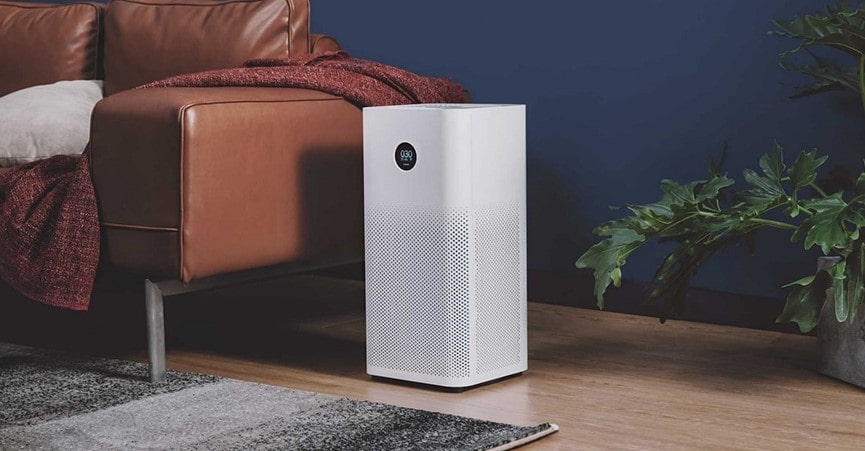

Air purifiers have become a fact of life especially since, according to the WHO, none of the districts in our country are pollution-free anymore. However, for the common man, it can be very difficult to provide clean air over and above food and housing to his family. Sticking to a budget can make it very difficult to do this which is why we have created this guide on the best air purifiers in India under ₹10,000.
To come up with this guide, we analyzed multiple options available in the market in terms of various features and capabilities of the devices. Our findings are listed in the form of in-depth reviews for your consideration.
Before those reviews, though, we’ve included everything you’ll ever need to know to not only be able to buy the best air purifiers in India but also to get the best out of them.
Note that we’ve paid special attention to room sizes since that is the first thing most people consider. Here’s everything you’ll find in this guide. Feel free to skip sections as per your discretion.
- Why do you Need the Best Air Purifier in India?
- Even the Top Air Purifiers in India are Only as Good as Their Users
- Which Air Purifier is Best in India and How Should you Choose one?
- 10 Best Room Air Purifiers in India Under ₹10,000: At a Glance
- Top 2 Air Purifiers in India Under ₹10,000 (Bedroom / Small Rooms): Detailed Reviews
- 4 Best Home Air Purifiers in India Under ₹10,000 (Dining Room / Medium Rooms): Detailed Reviews
- 4 Best Air Purifiers for Delhi & Large Rooms Under ₹10,000 (Living Room / Dining Hall): Detailed Reviews
Why do you Need the Best Air Purifier in India?
If you’re an observant person, you would notice that you breathe easier after it rains. If you live in a high-rise building, you’ll not only breathe easier but also see farther after rainfall. A good air purifier will do the same for you day in and day out.
Of course, if you suffer from asthma or any kind of allergy then you don’t need any introduction to air pollution. You live with it, suffer with it, and struggle through it every day.
However, if you’re one of those skeptics who are being forced to buy an air purifier because of other people’s beliefs, let us tell you that air pollution is a genuine health concern.
For instance, this 2010 American study featuring multiple Indian scientists found that the longer an individual is exposed to particulate matter, the higher the risks of the individual experiencing cardiovascular disease-related emergencies.
Similarly, a Mexican study from 2012 evaluated the effects of air pollution on mortality risk in people across 9 Latin American cities and found an increased risk of death due to exposure to air pollution.
Another more recent study conducted in 2018 by Chinese researchers established air pollution to be an independent trigger for cardiovascular diseases.
While we’ve only cited three, there are countless other studies from all over the world that explain how bad air pollution can be. Together, they establish that air pollution is indeed a health hazard that needs to be tackled instead of ignored.
The next logical question would be how. The best solution would be to get away from it all and live like a hermit in the hills. Unfortunately, even if we want to, this isn’t something that our jobs, lives, and lifestyle preferences permit.
The next best solution is to get an air purifier. However, if you’re a skeptic then you’ll want to be absolutely sure about their effectiveness. Luckily, they are, according to a study published in the official publication of the Indian Chest Society in 2015. The study clearly establishes that “efficient” air purifiers can reduce “particulate matter and allergens”.
Best Air Purifiers in India Under ₹10,000 for Small Rooms | Best Air Purifiers in India Under ₹10,000 for Medium Rooms | Best Air Purifiers in India Under ₹10,000 for Large Rooms |
Havells Freshia AP-20 | Philips AC1215/20 Air Purifier | Mi AC-M6-SC Air Purifier 3 |
A swanky-looking air purifier with 5-stage filtration and all the modes that you can ask for. | The most successful air purifier in this price segment from a market-leading company that offers all the bells and whistles that you can ask for. | The air purifier with the most advanced connectivity technology in this price bracket that offers exceptional purification along with complete app-based and voice-enabled controls. |
Even the Top Air Purifiers in India are Only as Good as Their Users
There are cavalier and ignorant people out there who will tell you that you don’t need an air purifier because they don’t work. Some will tell you that they’re a gimmick of big companies to get you to spend your hard-earned money.
To back their claims, they’ll say that the AQI indicator of the devices rarely ever show good air in the room and is entirely random and unpredictable. To further muddy the entire thing, they’ll falsely claim that they’ve tested it themselves at home and are speaking from experience.
Here’s the thing: Their personal experiences are right.
They really did try air purifiers at home and its AQI indicator really did seem random and unpredictable. However, this happened because they had no idea how to use their air purifiers.
First, they didn’t keep their doors and windows shut while using their air purifiers. If they did shut their windows and doors, they didn’t seal them with the proper seals.
If you allow dirty, outside air to come into your room regularly, even the most expensive and effective air purifiers will struggle to keep up. As a result, their AQI indicators will constantly shuffle between bad, normal, and good air statuses.
Another common complaint of people is that the air purifier companies are using these devices to get people to spend continuously. To justify this, these people explain how quickly the filters in their air purifiers need to be replaced.
However, it is again neglect and ignorance that are causing this problem. The more you expose your air purifier’s filter to polluted air, the more quickly it will need to be replaced.
For example, if you run the purifier all night and then promptly open doors and windows in the morning, you’ve taken all the benefits and poured them down the drain because all the purified air is now gone.
In its place, you have heavily polluted air that you’re asking your purifier to clean again in the afternoon. This kind of usage will require you to replace the filter much faster than if you kept the doors and windows shut during periods of heavy pollution.
For instance, the Delhi NCR region particularly experiences “severe” and “hazardous” levels of pollution in the winter months of November and December with “very poor” air quality being common in October and January. It is only after winds pick up in February that the air clears up. These months are precisely when you need to keep your doors and windows shut and sealed.
By the same principle, it is important to seal your house well if you want to get the most out of your air purifier. The best way to do this would be to install door seals at the bottom of all your doors and rubber seals on all your windows.
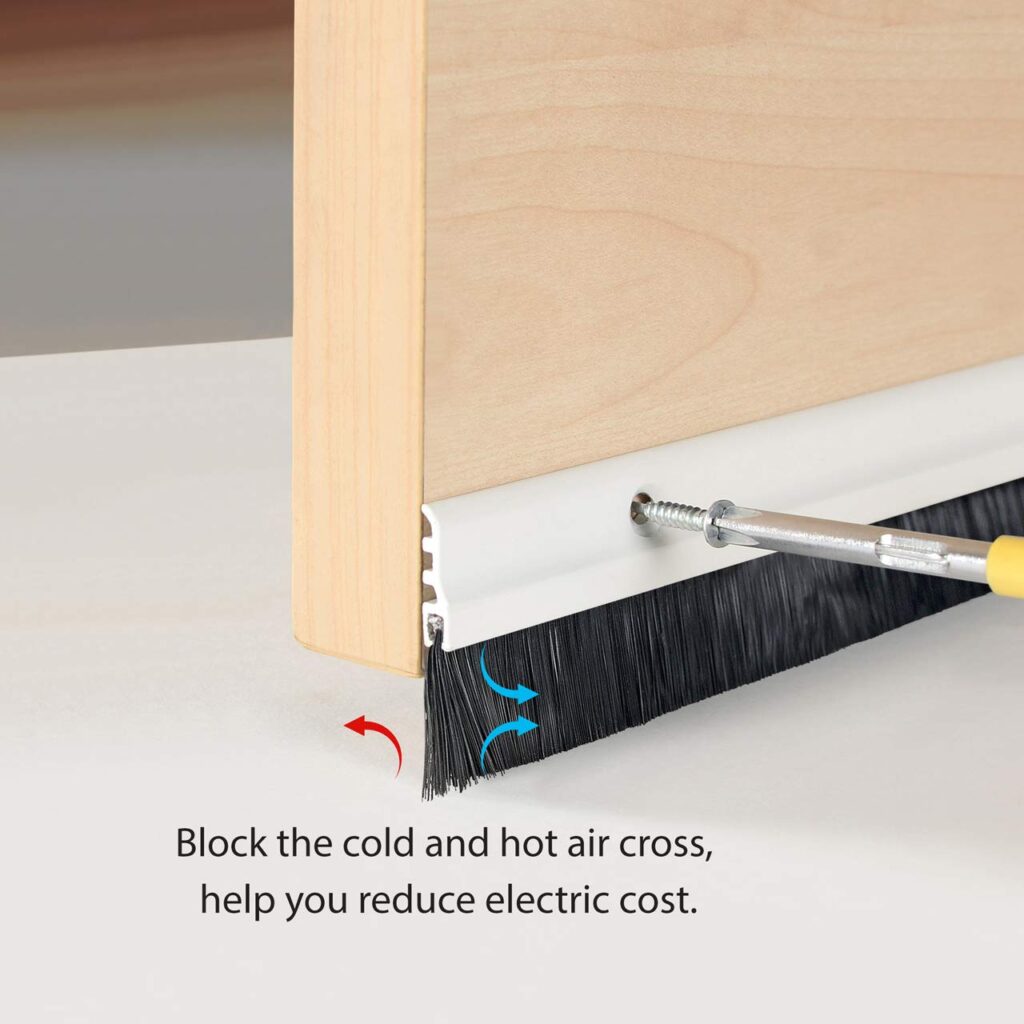



These seals aren’t the most expensive and can be purchased easily at any hardware store. However, we recommend measuring your doors before approaching the stores. They’ll cut the seals to the right dimensions and then you can install them yourself or hire a carpenter to do it for you.
The seals we’re talking about are metal strips with brushes at the bottom. You also get seals with rubber strips and all rubber seals online that are much easier to install but also less durable.
When installing these seals, we strongly recommend installing them on indoor doors too i.e., doors that don’t lead outside. This includes all your room doors and bathroom doors. After all, air purifiers are designed for individual rooms, not entire homes.
Which Air Purifier is Best in India and How Should you Choose one?
Most people choose air purifiers based on the recommended room size.
While this is a fairly suitable metric to base your decision on, it can lead to disappointment too. The reason for this is that when a company gives you the recommended room size, the calculations are based on ideal conditions. Typically, this means a well-sealed room without considerable leakage.
This is why it is always wiser to go for air purifiers intended for larger spaces. Unfortunately, this puts you in the under ₹20,000 air purifier bracket.
In practice, though, the room doesn’t have to be airtight but it does need to have all its cracks and holes covered properly. Even if you seal your room properly, you won’t be able to create the ideal conditions that air purifier manufacturers create when calculating the recommended room size of their devices.
Therefore, it is always a good idea to reduce the recommended room size or buy a bigger air purifier than what you think your room needs.
While recommended room size is something you can use to evaluate whether an air purifier will be suitable for your specific needs or not, there are other aspects worth considering. Let’s look at a few of these.
What is CADR in Air Purifiers?
CADR stands for Clean Air Delivery Rate. It is the speed with which the air purifier releases clean air. Typically expressed as volume per time, it shows the quantity of clean air the device can deliver every hour.
If you can calculate the volume of your room, you can compare it to the CADR value of the purifier you’re considering.


For instance, if you take a room measuring 10 feet in length, breadth, and height, the volume of air in your room will be 1000 cubic feet.
Since CADR is always calculated in meters let’s change the units to meters. 10 feet is about 3 meters. So, the 3 meters in length, breadth, and height give us a total volume of 27 cubic meters.
You can use this value along with the device’s CADR to figure out how quickly it can purify all the air in the room. Here are examples along with the most suited or best air purifiers for differently sized rooms.
- Small: This is the Havells Freshia AP-20 with a CADR of 180 m3 per hour. It should be able to completely change the air in your room in less than 10 minutes.
- Medium: For this, our top pick is the Philips AC1215/20 Air purifier with a CADR value of 270 m3 per hour. This device should do the job in your room in approximately 6 minutes.
- Large: For large rooms, we think the Mi AC-M6-SC Air Purifier 3 with a CADR of 380 m3 per hour is the best. This device will be able to purify the air in your room in just over 4 minutes. Incidentally, if you’re looking for the best air purifier in Delhi, this is the category we recommend you go for. The pollution in the NCR is such that you will not only need the top air purifier in India but also one that has a large capacity.
Of course, all these calculations don’t incorporate leakages or the constant opening and closing of doors and windows. Roughly speaking, if you add about 20 to 30 minutes to each of your estimates, you’ll arrive at a more accurate picture of the effectiveness of the device. The new figures with the added margins will fit how your chosen air purifier actually performs in your rooms.
What is HEPA Filter & HEPA Filter Grades?
There are various kinds of pollutants in the air. These include dust, pollen, gases, odors, and particulate matter.
A pre-filter is usually able to handle dust and similarly sized problems such as pet hair or dander.
Any activated carbon product whether in a cloth bag or filter will be able to handle the gases and odors.


It is the particulate matter that is difficult to deal with and this is where air purifiers with specialized HEPA filters come into play. This is why. Particulate matter is the most dangerous type of pollution especially compared to the others we just described.
Dust, pet hair, and dander gets stuck in our noses. It never reaches our lungs. Odor is an inconvenience at best and gases only become a problem if they’re of a particular variety such as those released by industries. Fortunately, most of us don’t live in industrial zones, so it’s not as much of a concern.
Particular matter, though, is prevalent in residential areas due to multiple reasons ranging from construction activities, traffic, and the burning of trash that is common practice. The poor also burn wood, charcoal, dung cakes for various reasons ranging from heat and cooking to worship. All this organic burning causes particulate matter.
HEPA filters remove this particular matter. HEPA stands for High-Efficiency Particulate Absorbent filter. These filters are extremely fine nets that trap particular matter while letting purified air through.
HEPA filters come in different grades ranging from H11 to H14. They’re graded on how effectively they can purify the air or what percentage of pollutants they can filter out. Consider.
- H11: >98% of pollutants
- H12: >95.5% of pollutants
- H13: >99.97% of pollutants
- H14: >99.975% of pollutants.
Naturally, the higher the grade of the HEPA filter, the better its purifying abilities will be. At the same time, the better it is at purifying, the denser it will be as a filter.
Therefore, the higher grade HEPA filters don’t let through as much air as lower grade ones too. Effectively, the CADR of air purifiers with higher grade HEPA filters can be lower than their competitors. In the long term, though, they will clean the air better so it will all balance out.
What Does the Ionizer do in Air Purifiers
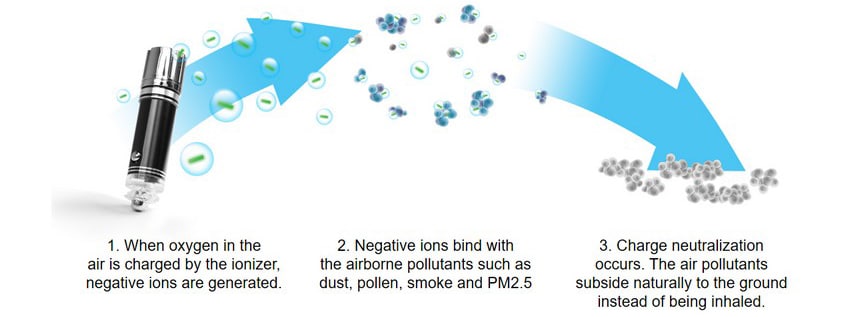

Many of the air purifiers you consider will also boast about incorporating an ionizer. Ionization is an active purification technique while filters purify the air passively.
Devices that come with ionizing capabilities produce negative ions in addition to purifying air through the filters. These negative ions then attach themselves to particulate matter and microorganisms in the air to get rid of their negative charge.
As they bond with particulate matter, they impart their charge to them causing them to stick with positively charged surfaces. This means everything in your room such as floors, walls, and furniture.
When the negative ions bond with microorganisms like bacteria and viruses, the negative ions end up inactivating, leaving them inert and unable to multiply.
While these qualities of ionizers are beyond doubt, it is also true that they can end up producing ozone when the negative ions bond with certain atmospheric gases.
Ozone is a pollutant as per the World Health Organization. It is also a respiratory irritant which means that its accumulation in the home can end up causing respiratory problems. Most ionizing technologies produce ozone but more recent developments in the field have resulted in this flaw being nullified.
For instance, some air purifiers release positively charged ions along with negatively charged ones. The result is that the anti-particulate matter and anti-microorganism qualities of ionization remain strong while ozone production is completely eliminated.
Therefore, if you’re interested in an air purifier with ionizing capabilities, we strongly suggest sticking to the more recent technologies.
Features of the Best Home Air Purifiers in India
While assessing the core technologies of the air purifier is important, you may want to review supporting features as well such as running modes and sensor technologies.
Having multiple running modes makes air purifiers more versatile and convenient to use.
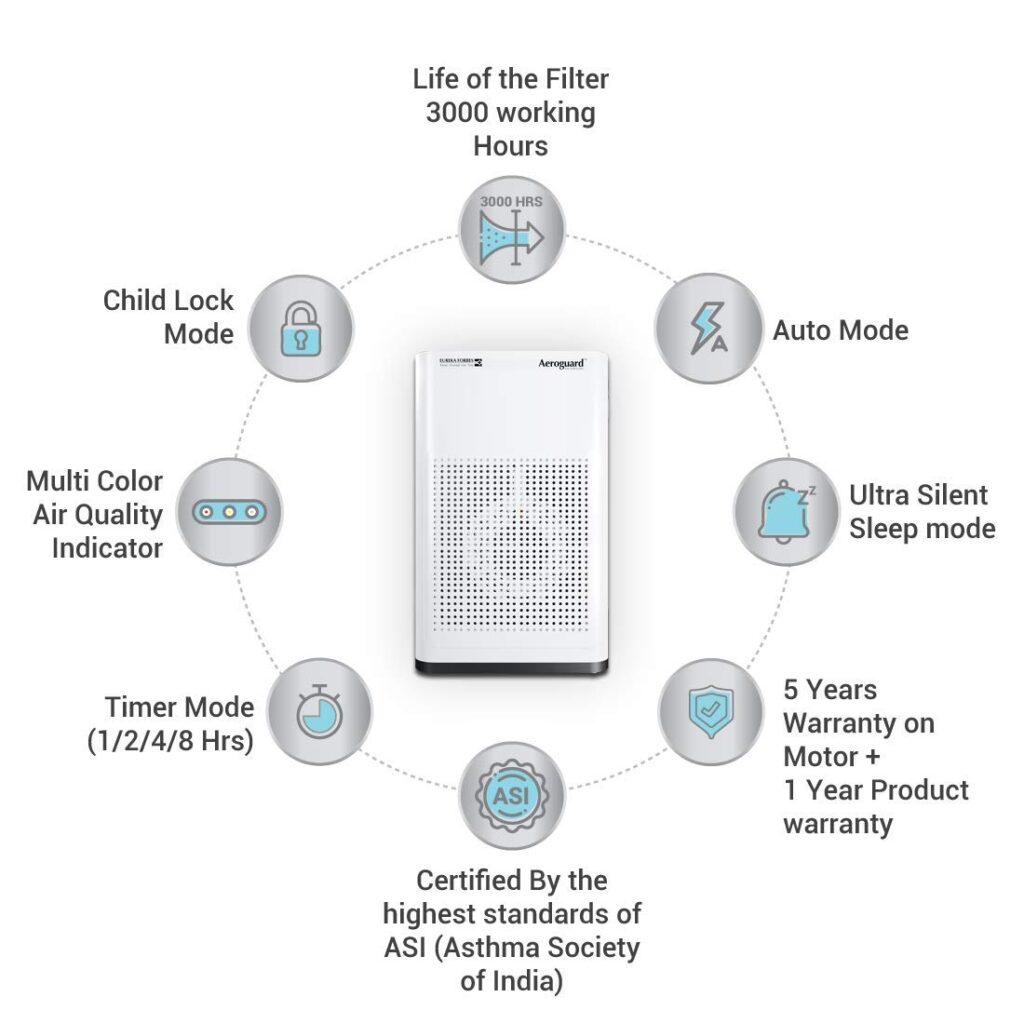

Further, some air purifiers monitor air quality and adjust the device’s running mode constantly while others sense the amount of light in the room to start sleep or night mode.
It is also a good idea to choose a device with an AQI indicator. AQI indicators monitor and display the quality of air in the room. In this price bracket, you won’t find many air purifiers that show the AQI of the room in numbers. The majority will, instead, have color-based AQI indicators.
Air purifiers with filter change indicators should also be preferred because they can free you from the responsibility of keeping track of filter life.
In the following sections, we’ll be reviewing the top 10 air purifiers in India categorized on the basis of their room capacities.
10 Best Room Air Purifiers in India Under ₹10,000: At a Glance
Product Name | CADR | Recommended Room Size | Price |
180 cu m/hr | 215 sq. ft. | ||
180 cu m/hr | 290 sq. ft. | ||
120 cu m/hr | 301.4 sq. ft. | ||
240 cu m/hr | 320 sq. ft. | ||
270 cu m/hr | 333 sq. ft. | ||
250 cu m/hr | 387.5 sq. ft. | ||
360 cu m/hr | 462.8 sq. ft. | ||
380 cu m/hr | 484 sq. ft. | ||
393 cu m/hr | 505 sq. ft. | ||
215 cu m/hr | 602 sq. ft. |
Top 2 Air Purifiers in India Under ₹10,000 (Bedroom / Small Rooms): Detailed Reviews
#1: Havells Freshia AP-20
Editor’s Rating: 8.0/10
Havells is a new name in the air purifier market. However, the electrical parts manufacturing company has been diversifying into a wide variety of new markets in recent years.
They’ve always manufactured excellent products so we’re not that surprised to find that the Havells Freshia AP-20 is good enough to qualify for our guide.


This is the entry-level model from this company which is why it is priced below ₹10,000. However, what you need to know is that it is only barely below the ₹10,000 mark. The other more advanced variants of this same device go as high as ₹19,000.
Even though it is the basic, entry-level model, it is pretty impressive when it comes to its core technology. Unlike many of its competitors, it uses True HEPA technology which essentially means that it has an H13 grade HEPA filter.
In fact, the entire filtration system of this device can be split into five stages which are pre-filter, cold catalyst, activated carbon, antibacterial, and HEPA.
While the entry-level nature of this device doesn’t affect its purification functionalities, it does affect how quickly it performs those functions.
For instance, the CADR value of this device is 180 m3 per hour which the company says is good enough for a room spanning 215 square feet. This makes it suitable for smaller rooms like the usual bedrooms.
Another exceptional quality of this device is that it comes with a remote control. The remote control is pretty useful, especially since the company categorically says that this device is ideal for bedrooms.
This device comes with the usual features and modes too which isn’t something that all its competitors can say. It offers 3 fan speeds along with a sleep mode and time setting feature. For AQI management, it will give you a color-based indicator with green, orange, and red the colors used.
It also has an odor sensor and an automated filter replacement indicator. The filter replacement is where Havells stumbles, however. In simple terms, the replacement filters aren’t easily available, especially when it comes to tier 2 and 3 cities.
Further, because the company is only now making a foray into these newer product segments, they don’t yet have the support network to back their products.
Therefore, despite the 2-year warranty which is more than what you’ll get with other products, the company is unable to honor it properly because of their poor sales network.
Who’s it for: If you want a well-built air purifier for smaller rooms that comes with a remote control, get this one from Havells.
Tech Specs | Pros | Cons |
|
|
|
#2: KENT Aura Room Air Purifier
Editor’s Rating: 7.5/10
Everyone in India knows Kent for its exceptional ROs and water purifiers.
In fact, it is highly likely that you already own a Kent RO or alkaline water purifier since water pollution and hardness in the country are no less problematic than air pollution.
The air purifier from the company, though, is also good enough to feature in our list of the 10 best air purifiers in India under ₹10,000.


It is best suited for smaller rooms because of its 180 m3 per hour CADR. The company’s recommended room size of 290 sq. ft., however, is a bit on the optimistic side. If your room is around the 200 sq. ft. mark then this product may be a good choice for you.
Similarly, the company also inflates its filter life when it comes to marketing. It says that its filters will either last for 7 months or 2,000 hours. Just for perspective, if you run your purifier for 24 hours (as you should), 2,000 hours would amount to less than 3 months.
Compare that with the 7-month claim and you’ll see the problem. At the same time, if your usage falls within the average usage metrics then 7 months sound about right.
In peak pollution, if you run this device round the clock, you shouldn’t expect any more than 3 months. Replacing the entire filter set, by the way, will cost you around ₹3,000. This is fairly standard in the industry.
In terms of how well it purifies the air, we have no complaints. This device features an H13 grade HEPA filter which is the standard with most air purifiers these days. The market is only now seeing the entry of H14 grade HEPA filters and for most people, H13 should be good enough.
Other than the HEPA filter, this device also features the pre-filter for catching dust and the activated carbon filter for capturing gases and odors. There’s even an inbuilt ionizer to supplement this barrier-based purification technology.
However, we’ll leave a warning here. This is the traditional ionization technology which means that it can cause ozone accumulation in your room.
The default setting of the ionizer in this device is “on” whether you turn the device on for the first time or whether it restarts after a power cut. Therefore, if you don’t want the ionization option, you’ll have to turn it off manually every time the device restarts.
Kent has also ensured that its product is full of the usual features such as three fan speeds, automatic and normal modes, a timer, and a child lock function. There’s also the usual color-based AQI indicator.
Where Kent’s air purifier differs from most others is that it comes with a printed body. While the color of the print can vary from one unit to another, the basic motif is flowers over a white background. Whether you like the design or not will depend on your preferences.
While the body of the air purifier is cheap plastic, it is no different from most of their products. The company even backs its product with a 1-year warranty. However, the problem arises when you need some kind of post-sales support because as good as the company’s technicians are with water purifiers, they’re quite poor with air purifiers.
Who’s it for: If you want an affordable air purifier with an ionizer from an Indian company, get the Kent Aura.
Tech Specs | Pros | Cons |
|
|
|
4 Best Home Air Purifiers in India Under ₹10,000 (Dining Room / Medium Rooms): Detailed Reviews
#1: Beurer 660.02 LR200 Compact Air Purifier
Editor’s Rating: 6.5/10
Beurer is a German company that has only recently entered the Indian market. The 660.02 LR200 is their smallest air purifier which is why they market it as a “compact air purifier”.
This device uses a 3-stage filtration system which comprises a pre-filter, an activated carbon filter, and an EPA filter. For all intents and purposes, an EPA filter can be seen as a HEPA filter.


EPA just stands for Efficient Particulate Absorbent filters instead of High-Efficiency Particulate Absorbent or HEPA because its purification efficiency is lower. This device uses an EPA12 filter which can be translated into an H12 grade HEPA filter in terms of how efficiently it purifies the air.
The barrier-based passive purification in this device is supplemented by the ionization function as in the case of Kent’s offering. The ionizer, however, can cause ozone accumulation in your room.
What is strange about this device is that it only boasts a CADR of 120 m3 per hour but claims to be suitable for a 300 sq. ft. room. We think this is an exaggeration in the same vein as Kent but the fact that it uses an EPA filter instead of a HEPA filter may be one explanation.
In terms of features, it is comparable again. It boasts a night mode, 3 fan speeds, a timer, and filter alarms. If you want more features, there are other considerably more powerful variants also available but they don’t fit within our chosen price segment.
Being new in the country, the company’s post-sales support infrastructure is lacking. As a result, not only will the replacement filters be harder to find but also significantly more expensive than other brands.
In terms of build quality, you should know that there have been some complaints about this device getting noisier the older it gets.
Who’s it for: If you want an air purifier manufactured by an international brand abroad, get this one from Beurer.
Tech Specs | Pros | Cons |
|
|
|
#2: Sharp FP-F40E-W Air Purifier
Editor’s Rating: 8.5/10
Sharp is the only company in the market that offers completely safe ionization technology.
Their patented ionization technology called Plasmacluster doesn’t cause any accumulation of ozone in the room because of one key difference.
This is the fact that their technology produces positive ions along with negative ions.
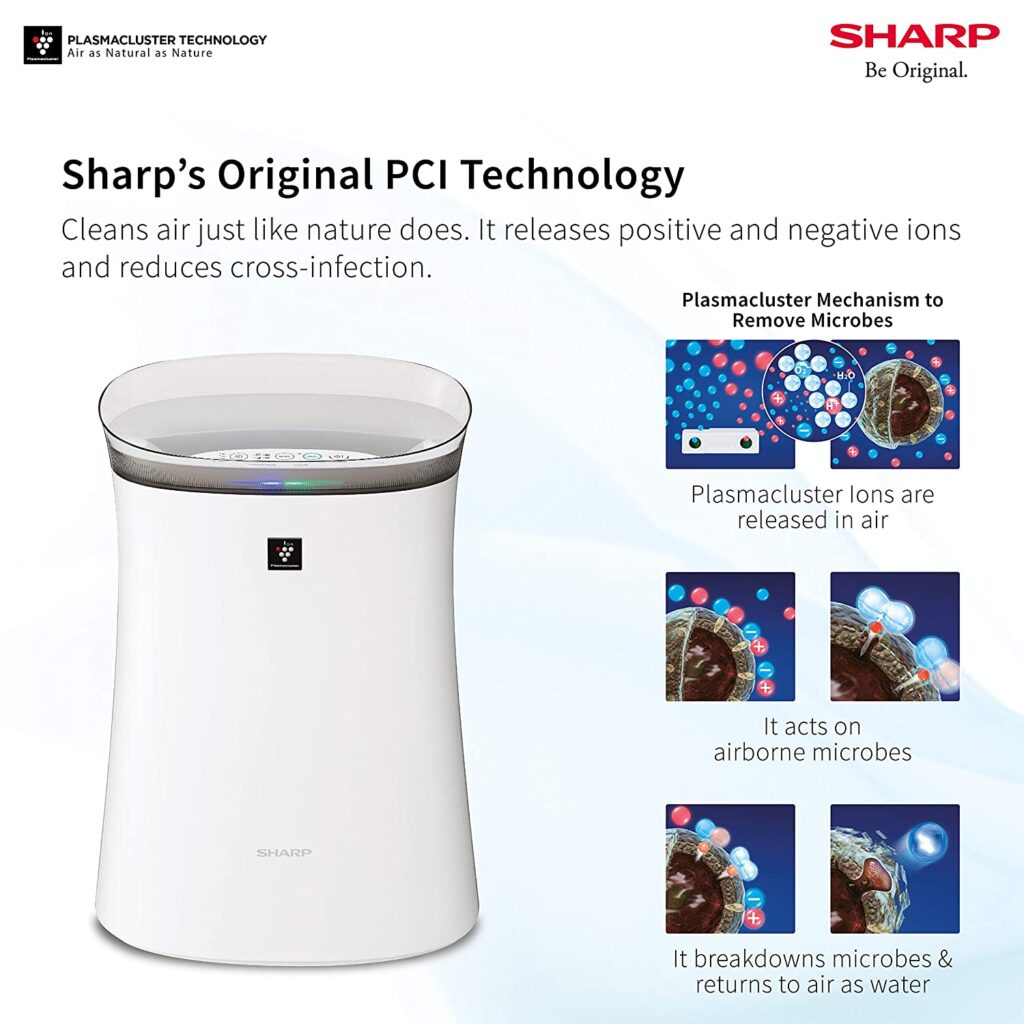

As a result, instead of making ozone, these ions end up making water molecules in the room. Effectively, this air purifier’s ionization technology also helps with humidification. This unique ionization technology is so good that Sharp has gotten certification from 30 global laboratories including IIT Delhi and the British Allergy Foundation.
The Plasmacluster technology in this device is supported by the typical passive purification of filters. This device uses a combination filter comprising elements for pre-filter, activated carbon filter, and HEPA filter.
The HEPA filter used in this air purifier is H14 grade. Because the combi-filter makes use of an H14 grade HEPA filter, it ends up costing twice as much as the filters of competing devices. On the other hand, this costing makes sense because the company says that its combi-filter will last for 24 months.
Another major issue with this device is that it doesn’t come with any filter change indicator. We think this is a major oversight from the designers of this device.
Other than these flaws, this air purifier is pretty impressive. It is built with Japanese technology because Sharp is a Japanese brand. The material used for the body of the filter is also ABS.
Further, the design of this device is such that it creates a 20° airflow in the room. This means that its airflow encompasses both the roof and the floor of the room.
We also need to talk about its CADR and recommended room size. With a CADR of 240 m3 per hour, this air purifier would be suitable for a room measuring somewhere between 200 and 250 sq. ft.
Sharp, however, says that it is great for rooms as large as 320 sq. ft. While the design modification ensuring better airflow will help to a certain extent, we still don’t think you should be buying this air purifier for rooms larger than 275 sq. ft.
There are 3 different modes to choose from which are high, medium, and low. There’s also the usual color-based AQI indicator.
Sharp also backs its device with a 1-year warranty and is pretty diligent in honoring its commitments through reliable post-sales service.
Who’s it for: If you want an ionizing air purifier that doesn’t produce a lot of ozone, get this device from Sharp with its unique Plasmacluster Technology.
Tech Specs | Pros | Cons |
|
|
|
#3: Philips AC1215/20 Air purifier
Editor’s Rating: 9.0/10
There’s a reason why Philips is the market leader in India when it comes to air purifiers.
It doesn’t even matter which price segment or room size you consider. Philips’ devices beat all their competitors very comfortably.
Take this AC1215/20 air purifier for example.


If you set aside their ultra-small portable air purifier, this device is their entry-level offering and one of the best in the market in terms of all areas of concern.
It not only purifies the air well and offers numerous features but also does it without requiring you to spend loads of money on replacement filters.
It has a CADR value of 270 m3 per hour which is good enough for a room just over 200 sq. ft. The company, though, says that it will be able to purify a room as large as 333 sq. ft. but we think for that to happen you’ll need to not only seal the room properly but also use the device in a period of relatively low pollution levels.
To illustrate their device’s capabilities, Philips says that this air purifier will be able to purify a room measuring 18 ft. x 12 ft. x 8 ft. in less than 12 minutes.
The device uses a 4-stage filtration system that comprises a pre-filter, an activated carbon filter, and a double-layered True HEPA H13 grade filter.
The nature of the HEPA filter in an air purifier is its most important variable. In this device, the filter ensures multiple things. The first is that it purifies the air well, resulting in a certification from the European Centre for Allergy Research Foundation or ECARF.
The second is that it lasts longer than what is seen in competing products. While the company doesn’t make any claims, you won’t have to change your filter for a minimum of six months. If the pollution levels are lower or you use the device lesser, then it can even last for the whole year.
You don’t have to worry about it, though. The device will tell you when it’s time to change the HEPA filter. It will even tell you when you need to clean the pre-filter with a different error code.
The purification of this air purifier is good enough for it to remove 99.97% of airborne pollutants including PM2.5 and lower. The company calls this technology Vitashield Intelligent.
As to how you can tell whether the air is being purified, the device comes with a color-based AQI indicator. It is pretty accurate too, as is the case with most air purifiers from reliable companies.
The device also comes with three automatic modes. These are general for all types of pollutants, allergen for allergy-specific purification, and NightSense which you should use while sleeping.
The NightSense mode allows the device to sense the level of light in the room and turn off the display. Further, when you turn it on, the device will try to purify as much of the room as possible within the next 15 minutes before reducing its fan speed to make the least amount of noise.
At different points in the night, the device may ramp up purification and sound for small periods but this is only to cope with increasing pollution in the room. The NightSense mode is the main reason why this device is so exceptional. The mode works well even though it has one flaw. It is erratic about sensing the light in the room and doesn’t turn off like it’s supposed to.
Other than these modes, you’ll also have the option to manually choose from four different fan speeds. There’s also a child lock for homes with fiddle-some toddlers.
Who’s it for: If you’re not finicky about having an app or WIFI-based budget air purifier, this device from Philips is the best in the market.
Tech Specs | Pros | Cons |
|
|
|
#4: Honeywell HC000017/AP/V2 Air Touch V2 Air Purifier
Editor’s Rating: 7.5/10
Honeywell’s HC000017/AP/V2 Air Touch air purifier is very similar to the Philips device we’ve reviewed above.
It has a similar CADR and even the same kind of air filtration system along with similar features.
The only difference is the status of the company in the country. While Philips is the market leader, Honeywell is not, at least in home air purifiers.
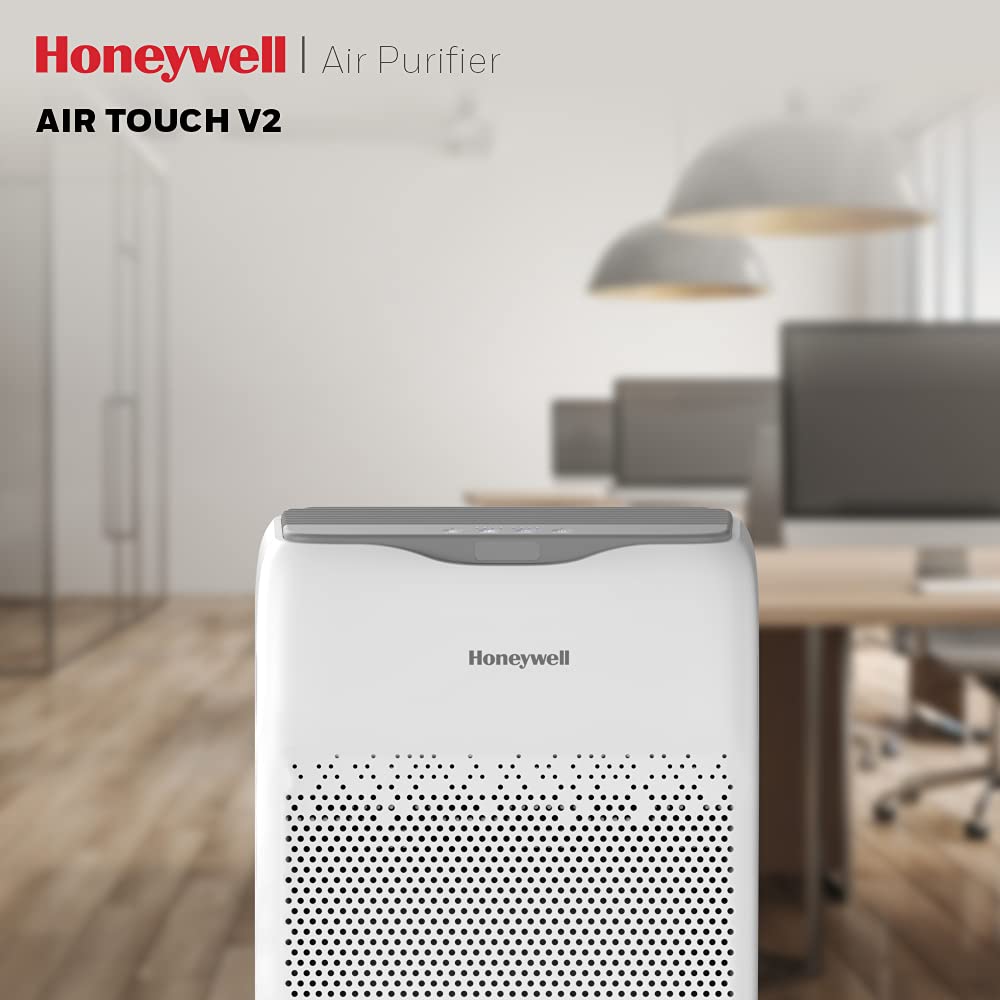

However, Honeywell’s air purifier is good too. While its CADR of 250 m3 per hour is lower than the 270 m3 per hour CADR of the previously reviewed Philips’s air purifier, Honeywell still claims that its device is suitable for a considerably bigger room of 387.5 sq. ft.
We’re sure that they’re citing the maximum possible figure here and don’t believe it at all. We think this device’s range is the same as a room between 200 and 250 sq. ft.
At the same time, we believe Honeywell when they say that their device is fast enough to change the air in most rooms five times every hour. Their air filtration system comprises the standard pre-filter and activated carbon filter along with the H13 grade HEPA filter.
Even the filter life claimed by the company is similar to what we specified while reviewing Philips’s product earlier i.e., 1 year. Honeywell goes one step ahead and also says 3,000 hours, which amounts to about 4 months of non-stop 24-hour operation.
On average, though, we’ll say that 6 months to 1 year is what you should expect if you use your purifier a lot. You’ll get a filter change alert from the device as soon as its filter needs replacing.
The device has the right features too. It has 2 air purifying speeds and an auto mode. The auto mode senses the state of the air in the room and adjusts the speed with which the device purifies it. This mode, however, is quite irregular, finicky, and unpredictable in its behavior.
Other than the annoying auto mode, the biggest flaw of this air purifier is that it becomes noisier the older it gets. This is despite the company’s claim that this device’s sound output never exceeds 50 dB.
There’s also a sleep mode and automatic shut-off timer options. These are 1, 2, 4, and 8 hours.
Like most air purifiers in this price bracket, this one also comes with a 1-year on-site warranty.
Who’s it for: If you’re looking for an alternative to Philips’s entry-level air purifier, go for this one from Honeywell with similar features and capabilities.
Tech Specs | Pros | Cons |
|
|
|
4 Best Air Purifiers for Delhi & Large Rooms Under ₹10,000 (Living Room / Dining Hall): Detailed Reviews
#1: AmazonBasics AB_2020_AP1 Air Purifier
Editor’s Rating: 8.0/10
Amazon’s strategy of taking the best aspects of various products in a market segment, stuffing them all into their own product, and then offering the finished article at throwaway prices is very impressive.
They’ve perfected this strategy to a point where it is, frankly, quite ridiculous. Take the AB_2020_AP1 air purifier sold under the AmazonBasics brand.
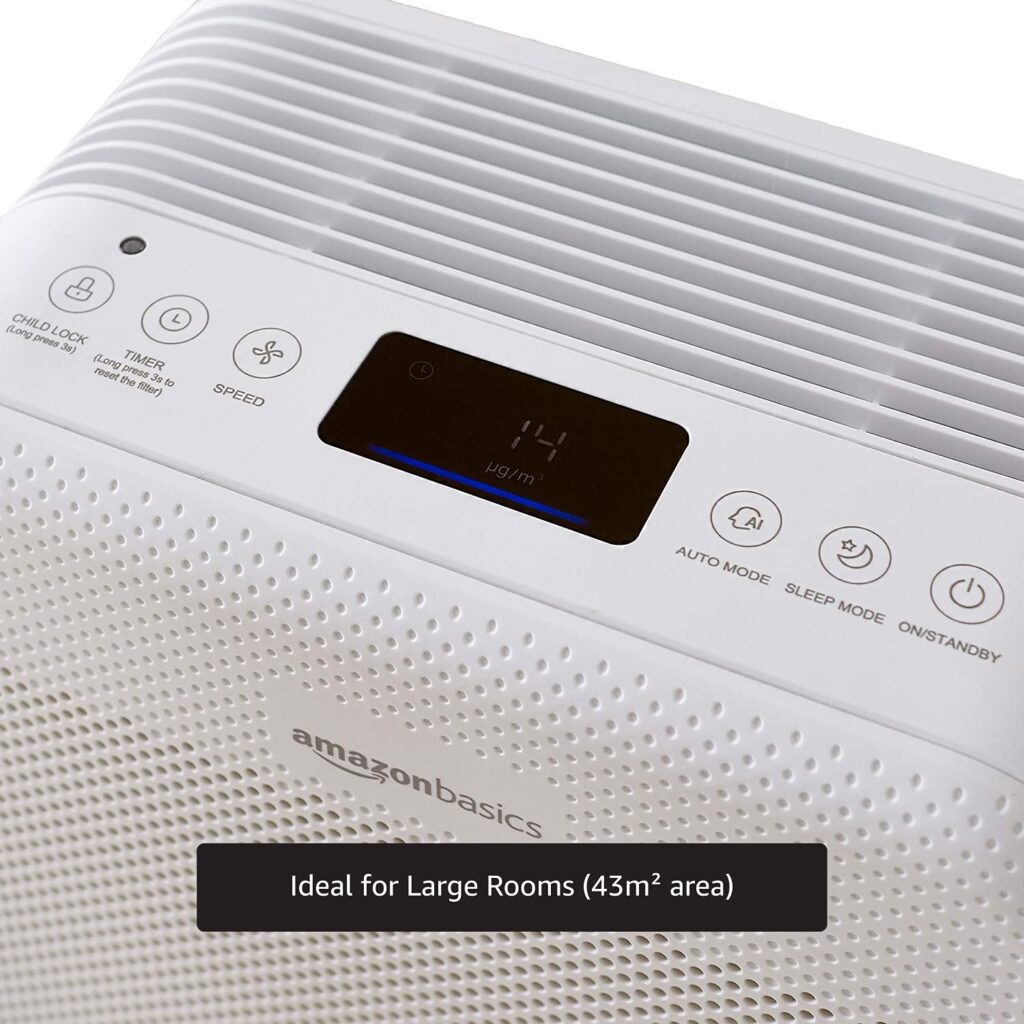

In this case, the eCommerce giant has not only made sure that its product has the best features in the market but has actually improved upon those capabilities.
For instance, this device has the greatest CADR in the industry within this price bracket. Naturally, the highest CADR means that this device can be used in larger rooms. With a CADR of 360 m3 per hour, you can expect this air purifier to be sufficient even if your room spans around 300 to 350 sq. ft. even though the company claims 462.8 sq. ft.
The quality of air it provides is better too since it has a 5-stage filtration system highlighted by an H14 grade HEPA filter. H14 grade HEPA filters are new to the Indian market and only three devices within this price bracket are offering them. Other than the earlier reviewed Sharp air purifier and this one from AmazonBasics, there’s only the Eureka Forbes air purifier.
The only problem is that this product doesn’t have the same support ecosystem that market leaders boast of. The biggest example of this is that you’ll have an incredibly difficult time finding replacement filters for this device.
Even contacting Amazon’s famed customer support wouldn’t help in that regard, although the product is supported by a 1-year guarantee.
In terms of usage again, Amazon has ensured that its air purifier has all the modes and options that the best products in the industry boast.
There are two working modes including the automatic mode that modifies fan speed based on air pollution in the room. The automatic mode relies on the device’s inbuilt monitor function that shows air quality in three colors.
The other is the Sleep mode which reduces the fan speed and sound output while lowering the display lights to ensure undisturbed nights. There’s also a light sensor that kills the display when the ambient light goes down.
Manually speaking, there are 3 fan speeds to choose from, a child lock, and a timer function too.
Features-wise, the biggest issue with this device is that it doesn’t turn on automatically after a power cut. This, we feel, is a silly oversight on the part of Amazon in a country like India where power cuts are a regular problem.
Who’s it for: If you want a super-cheap air purifier that can compete with market giants in capabilities, features, and options, get this one from AmazonBasics.
Tech Specs | Pros | Cons |
|
|
|
#2: Mi AC-M6-SC Air Purifier 3
Editor’s Rating: 9.0/10
In terms of how modern an air purifier is, you won’t find any that is better than this one from Mi.
The Mi AC-M6-SC Air Purifier 3 is special because it comes with complete WIFI compatibility.
This means that you can download the Mi app and control your air purifier from anywhere in the house.
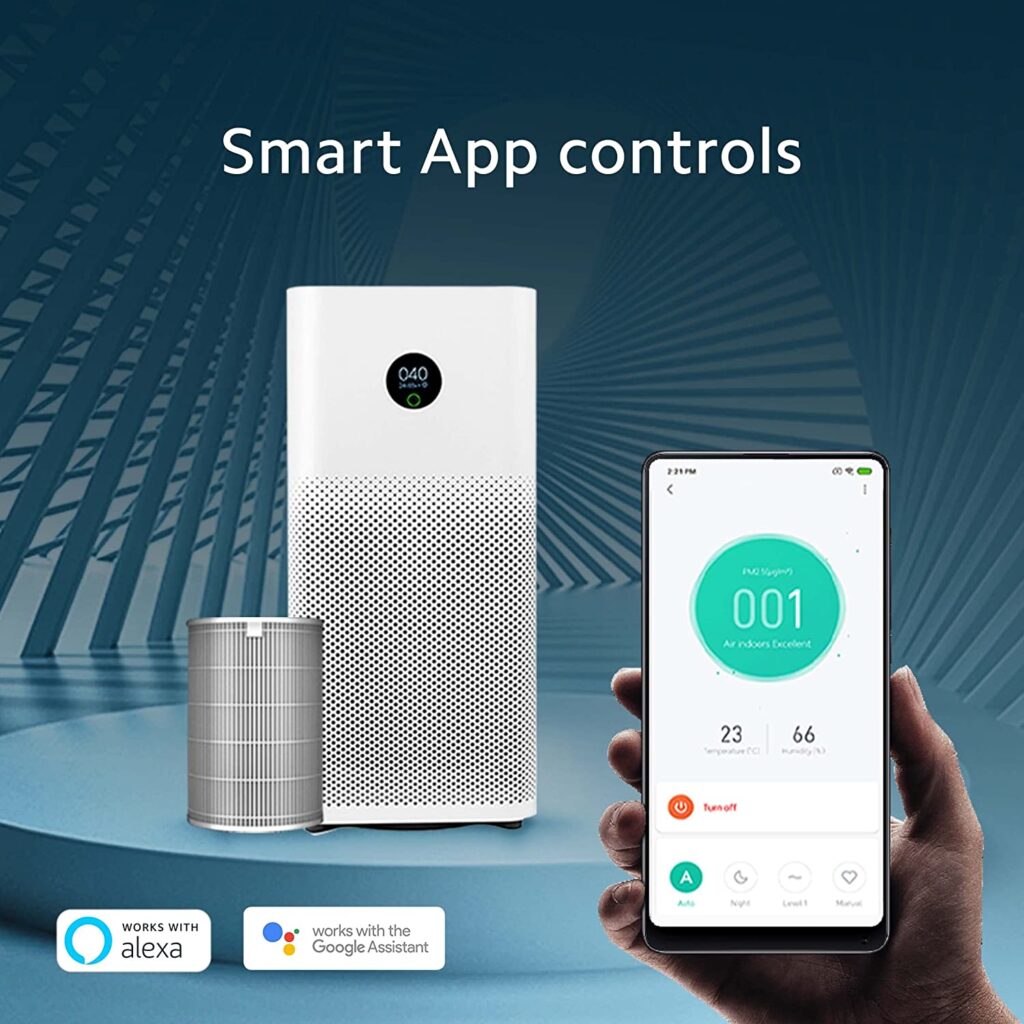

Additionally, it also means that your air purifier now responds to voice commands directed through either Amazon’s Alexa or Google’s Voice Assistant.
Therefore, if you have Amazon Echo Dot or Google’s Home device, you can order your air purifier from anywhere in your home without lifting even a finger. There’s even an air purifier and echo dot combo available.
While the biggest strength of this device is its connective superiority, it also happens to be one of its flaws. The reason for this is that setting it all up can get a little complicated for people who are not technologically savvy.
The trick is to have both the air purifier and the smartphone or tablet on the same WIFI network. Once this is done, you can download the app and it should show your new air purifier in the interface.
The majority of modern features that this device offers are accessed through the app itself. For instance, it can show real-time PM 2.5 concentration in your room along with other key environmental metrics such as temperature and humidity. Of course, you’ll be able to change modes and settings through it too.
In terms of the core purpose, this air purifier performs well too. It has a much bigger CADR of 380 m3 per hour than competing devices in the same price bracket. Unfortunately, the higher CADR does mean that this device is noisier than its competitors.
On the other hand, the high CADR allows this device to be suitable for rooms with areas between 350 and 400 sq. ft. In fact, it comes pretty close to being suitable for +400 sq. ft. rooms, especially if you seal the doors and windows properly.
If you want a smaller air purifier too, Mi offers a combo where it combines this air purifier with the smaller and slightly less advanced Mi 2C purifier.
The company also boasts a 360-degree air intake design feature of this device which means that it pulls in air from all sides. This design feature makes the device slightly more efficient than its competitors.
The filtration system is 3-stage including a pre-filter, an activated carbon filter, and a HEPA filter. While the HEPA filter isn’t H14 grade, its H13 grade HEPA filter is still modern and capable of handling even high levels of pollution.
The HEPA filter has a good life too. It will last a minimum of 6 months and can even stay with you as long as 12 months. Mi will also help you plan for the future by allowing you to buy a combo that combines the air purifier and a spare filter.
This air purifier will come with a 1-year warranty as is the case in the industry.
Who’s it for: If you want WIFI-based app connectivity or voice control over your air purifier, this one from Mi is the best option.
Tech Specs | Pros | Cons |
|
|
|
#3: X-XONIER 123654 Air Purifier with Remote Control
Editor’s Rating: 6.0/10
Other than the Mi air purifier that we’ve reviewed above and the Havells air purifier, this is the only option you have if you want the ability to change the settings of your air purifier without moving from your seat.
However, like the Havells product, this device isn’t WIFI or app-based. It just comes with remote control.


This is a surprisingly simple way of dealing with this issue. The only reason that other air purifiers don’t come with a remote control is that not many people need that functionality from their air purifiers.
This device’s remote control is elaborate too and contains buttons for all its features. For instance, you can not only use it to turn on and off the device but also change various settings and modes.
The features themselves are impressive, especially if you consider the fact that this device is at least ₹5,000 cheaper than all the competing devices. It comes with the automatic mode, the night mode, multiple fan speeds, the timer function, and even an ionizer.
The ionizer, of course, means that it generates negative ions to deal with viruses and bacteria. It also means that it ends up producing ozone in the room which is a pollutant of a different type.
Including the ionizer function, this device has a 4-stage filtration system. The other three stages are the pre-filter, the activated carbon filter, and the HEPA filter. The surprising aspect of this device is that despite its low cost, it has an H13 HEPA filter.
Even its CADR is impressive at 393 m3 per hour. This makes this air purifier suitable for rooms up to 400 sq. ft. area and possibly effective in rooms spanning up to 450 sq. ft.
The company, like many others in the industry, gives the recommended room size of 505 sq. ft. based on ideal conditions and sealing protocols. They also say that this device can purify the standard room within 8 minutes. According to the company, the standard room measures 18 ft. x 12 ft. x 8 ft.
Another surprising aspect of this device is that it displays real-time AQI of the room. This monitor is what the auto mode is based on.
While the combination of features and purification capabilities in this air purifier is very impressive considering its super-low price, you have to realize that the company must have cut corners somewhere. We know where.
First, the build quality of this product is ridiculously low. It seems to be made up of super-cheap and unfinished plastic. Further, the company has next to zero support infrastructure in India.
Therefore, if something were to go wrong with your device, you can forget about any post-sales support from them. Additionally, they’ve not made much of an effort to ensure replacement filter availability. Once your filters are all used up, this device will turn into an expensive freestanding fan.
Who’s it for: If you want a super-cheap air purifier with a remote control and don’t fuss about the finish of the product much, get this one from X-Xonier.
Tech Specs | Pros | Cons |
|
|
|
#4: Eureka Forbes Aeroguard AP 700 Air Purifier with H1N1 filter
Editor’s Rating: 8.5/10
Eureka Forbes is not exactly a company that is known for its air purifiers. In fact, it is more of a competitor for Kent in the water purifier industry than any other company.
The company has been diversifying in recent years which is how we have the Aeroguard AP 700 air purifier. This device isn’t far from being the best product in the industry either.
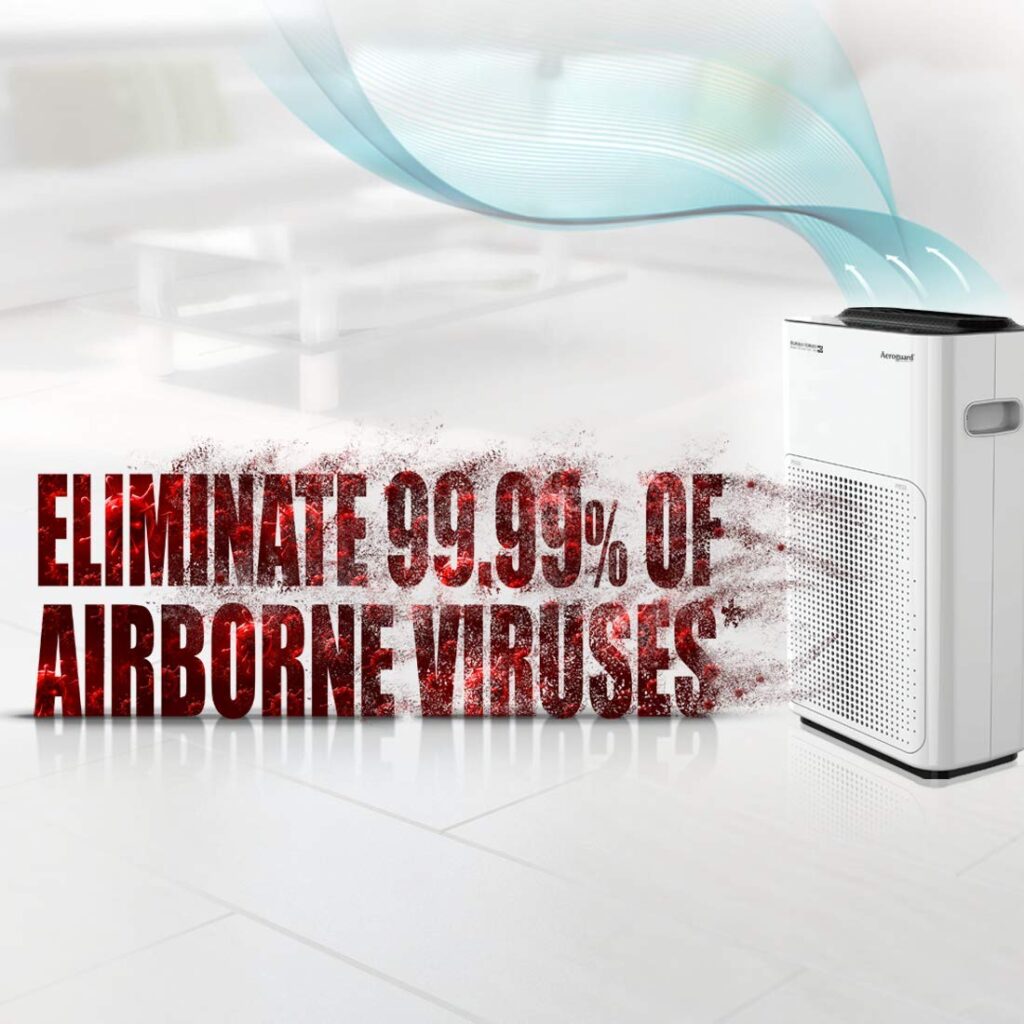

The only thing stopping it from being that is that the manufacturer hasn’t committed to it to the same extent that other market leaders like Philips have committed to theirs.
The best example of this is the fact that the company’s post-sales service is poor and replacement filters are not easily available for this device. Therefore, while you’ll get an awesome product when you pull the trigger on this air purifier, all that awesomeness will only last till the first thing goes wrong or the filters get clogged.
As to why, we think this is such a great standalone product, let us explain.
Eureka Forbes says that this is a great product because it comes with the Complete Disease Protection system. Translation: this product has a 6-stage filtration process.
The base, of course, is the pre-filter, the activated carbon filter, and the HEPA filter but there are 3 more which are the lung filter, the anti-bacterial filter, and the H1N1 filter.
The lung filter supports the pre-filter and protects the HEPA filter by capturing dust particles between 5 to 10 microns in size. The anti-bacterial filter targets bacteria of different types while the H1N1 filter is tailor-made to deal with viruses of various types. Yes, this includes the Covid-19 coronavirus too.
The HEPA filter in this device, by the way, is described as a UHD HEPA filter. While the company hasn’t specified the grade, the fact that they’re calling it Ultra-High Density and claiming that it removes 99.99 of airborne viruses makes us think that it is H14.
Moreover, since the product is one of the more recent to be launched, it makes sense for it to have an H14 grade HEPA filter.
The strangest aspect of this air purifier is that it has a CADR value of 215 m3 per hour but the company says that it is suitable for a room as large as 602 sq. ft. We’re not believing it especially since it has 6 filters and each filter slows down the air exchange that much more.
However, if you give it enough time in a sealed room, it will end up purifying all the air in it. Perhaps, that is what the company means. As it is, we think this air purifier is best suited for rooms that measure around 250 sq. ft.
Even if you take into account some revolutionary design modifications, you’ll get extra coverage of 25 to 50 sq. ft at most. Nowhere would it be possible for it to cope with a room more than 600 sq. ft. unless the conditions are heavily controlled.
In terms of purification quality, though, this is an exceptional air purifier. It is possible that its purification is as good as Sharp and Philips products. The 6 filters ensure complete purification which is why it has a certification from the Asthma Society of India.
The issue with this device, by the way, is the filters. The company doesn’t have enough of a support infrastructure for its air purifiers which is why replacement filters are so rare.
You’ll need the filters soon too because the company says they last for 4 months of non-stop use. In normal use, this would mean anything between 6 to 12 months depending on pollution levels.
Even if you contact the company directly, you’ll have trouble finding the replacement filters. The same applies to any kind of post-sales support with the technicians either being unavailable or incompetent. As a result of this, Eureka Forbes’ impressive warranty pairing of 1-year general and 5-year motor falls flat.
Features-wise, this product is at par with others in the market. It has the usual sleep and auto modes along with timer and child functions. There’s also the color-based AQI indicator that is helpful in judging how effective your air purifier is.
Who’s it for: If you want an air purifier with specialized anti-microbial technology without depending on ionization, get this product from Eureka Forbes.
Tech Specs | Pros | Cons |
|
|
|
Contents




